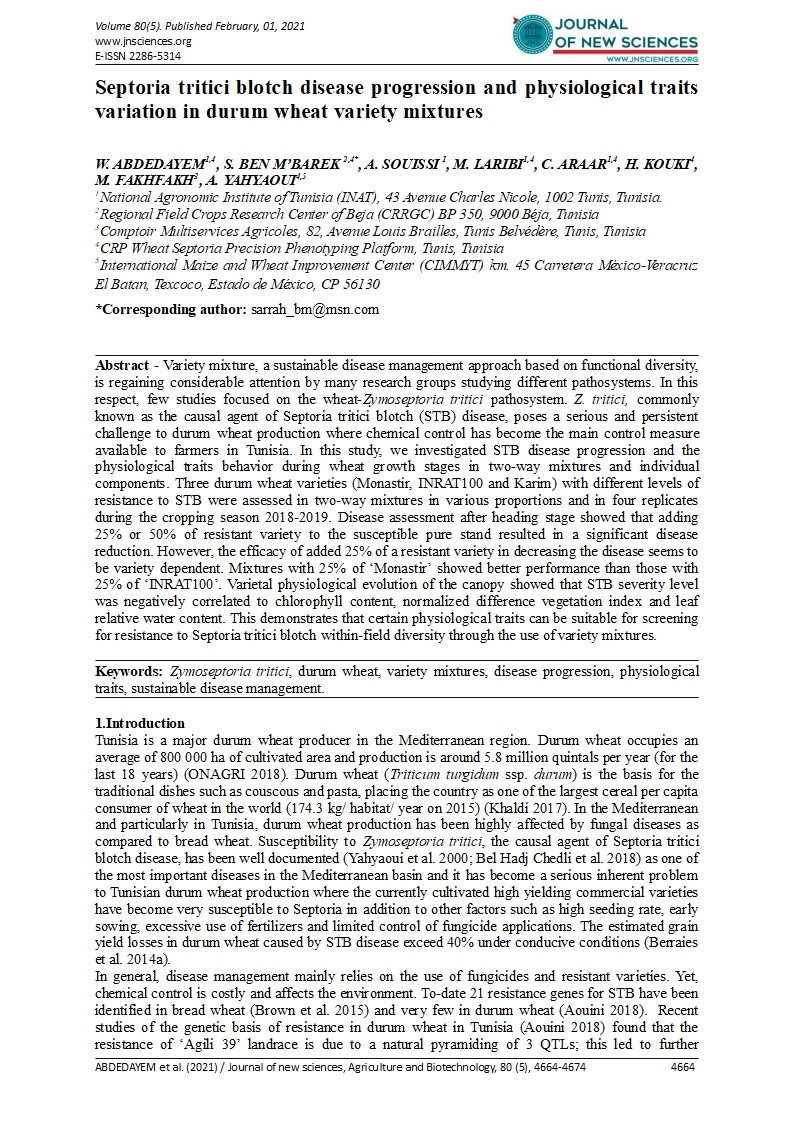

Septoria tritici blotch disease progression and physiological traits variation in durum wheat variety mixtures
W. ABDEDAYEM1,4
S. BEN M’BAREK 2,4
A. SOUISSI 1
M. LARIBI1,4
C. ARAAR1,4
H. KOUKI4
M. FAKHFAKH3
A. YAHYAOUI4,5
1National Agronomic Institute of Tunisia (INAT), 43 Avenue Charles Nicole, 1002 Tunis, Tunisia.
2Regional Field Crops Research Center of Beja (CRRGC) BP 350, 9000 Béja, Tunisia
3Comptoir Multiservices Agricoles, 82, Avenue Louis Brailles, Tunis Belvédère, Tunis, Tunisia
4CRP Wheat Septoria Precision Phenotyping Platform, Tunis, Tunisia
5International Maize and Wheat Improvement Center (CIMMYT) km. 45 Carretera México-Veracruz El Batan, Texcoco, Estado de México, CP 56130
Abstract - Variety mixture, a sustainable disease management approach based on functional diversity, is regaining considerable attention by many research groups studying different pathosystems. In this respect, few studies focused on the wheat-Zymoseptoria tritici pathosystem. Z. tritici, commonly known as the causal agent of Septoria tritici blotch (STB) disease, poses a serious and persistent challenge to durum wheat production where chemical control has become the main control measure available to farmers in Tunisia. In this study, we investigated STB disease progression and the physiological traits behavior during wheat growth stages in two-way mixtures and individual components. Three durum wheat varieties (Monastir, INRAT100 and Karim) with different levels of resistance to STB were assessed in two-way mixtures in various proportions and in four replicates during the cropping season 2018-2019. Disease assessment after heading stage showed that adding 25% or 50% of resistant variety to the susceptible pure stand resulted in a significant disease reduction. However, the efficacy of added 25% of a resistant variety in decreasing the disease seems to be variety dependent. Mixtures with 25% of ‘Monastir’ showed better performance than those with 25% of ‘INRAT100’. Varietal physiological evolution of the canopy showed that STB severity level was negatively correlated to chlorophyll content, normalized difference vegetation index and leaf relative water content. This demonstrates that certain physiological traits can be suitable for screening for resistance to Septoria tritici blotch within-field diversity through the use of variety mixtures.
Keywords: Zymoseptoria tritici, durum wheat, variety mixtures, disease progression, physiological traits, sustainable disease management.
